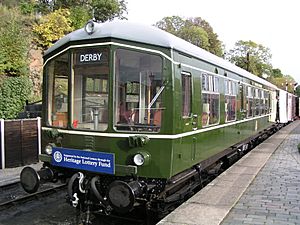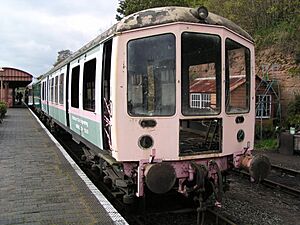British Rail Derby Lightweight facts for kids
The British Rail Derby Lightweight trains were a special type of diesel multiple unit (DMU). These were the first trains of their kind built in large numbers for British Railways. They were made at BR's Derby factory between 1954 and 1955. These trains came in different setups, including single cars, two-car units, and even four-car units. They were designed to be light and efficient for their time.
Quick facts for kids British Rail Derby Lightweight |
|
|---|---|

Derby Lightweight power car no. 79018 on display at Bewdley on the Severn Valley Railway on 15th October 2004, as part of the Railcar 50 event. This vehicle has been restored to its original condition using a grant from the lottery heritage fund, and is preserved at the Midland Railway Centre.
|
|
| In service | 1954-1969 |
| Manufacturer | BR's Derby Works |
| Number built | 219 vehicles |
| Formation | 1, 2 & 4 Car Formations |
| Operator(s) | British Rail |
| Specifications | |
| Maximum speed | 62 mph |
| Prime mover(s) | Two BUT (Leyland) 125 bhp |

Contents
What Made Derby Lightweight Trains Special?
The Derby Lightweight trains were important because they were among the first modern diesel trains in Britain. They helped to replace older steam trains on many routes. Being "lightweight" meant they were more fuel-efficient and could speed up and slow down quickly. This made them great for local services with many stops.
How Were They Built?
These trains were built by British Rail at their Derby Works. This factory was well-known for making railway carriages and wagons. The construction took place from 1954 to 1955. A total of 219 vehicles were made.
Different Train Setups
The Derby Lightweight trains came in several different arrangements:
- Two single-car units, which could run by themselves.
- Twelve two-car units, where both cars had engines (called "power-twin").
- Eighty-four two-car units, where one car had an engine and the other was a trailer.
- Four four-car units, for busier routes.
Where Did They Run?
These trains served many different lines across Britain. They were especially useful on routes where passenger numbers were not very high. Their design allowed them to be flexible and efficient for various local services.
How Fast Could They Go?
The Derby Lightweight trains could reach a top speed of 62 miles per hour (about 100 km/h). This was a good speed for the local and regional services they operated. Each power car had two engines, each producing 125 horsepower.
When Were They Used?
These trains were in service for about 15 years. They started running in 1954 and were gradually taken out of service by 1969. Many were replaced by newer, more powerful diesel trains.
Preserved Trains
Even though most Derby Lightweight trains are no longer in service, some have been saved. These preserved trains are often found at heritage railways. They help people learn about the history of British railways. For example, one power car, no. 79018, has been fully restored. It is now at the Midland Railway Centre. Another trailer car, no. 975008, is also preserved there.
Images for kids


